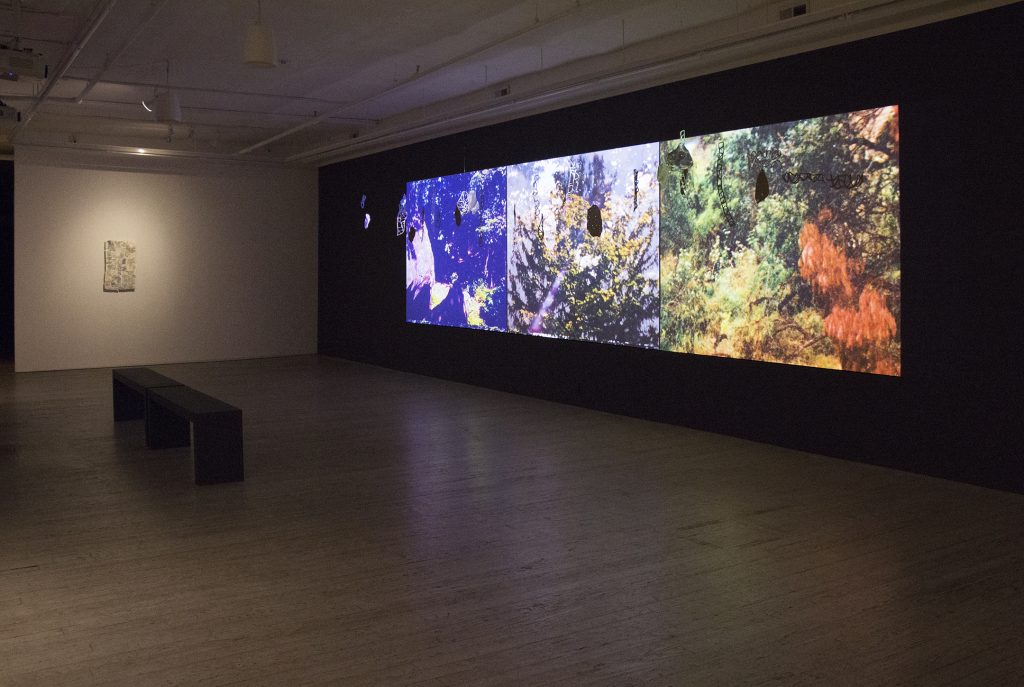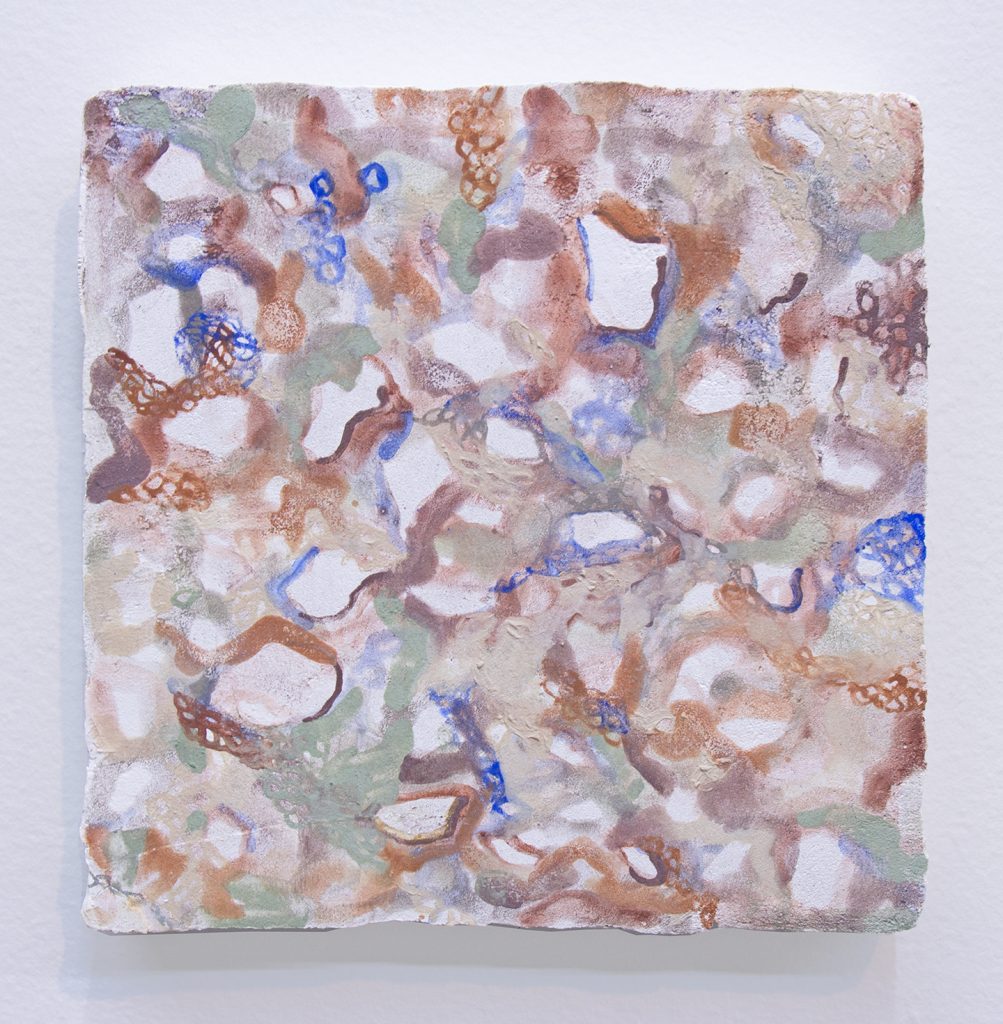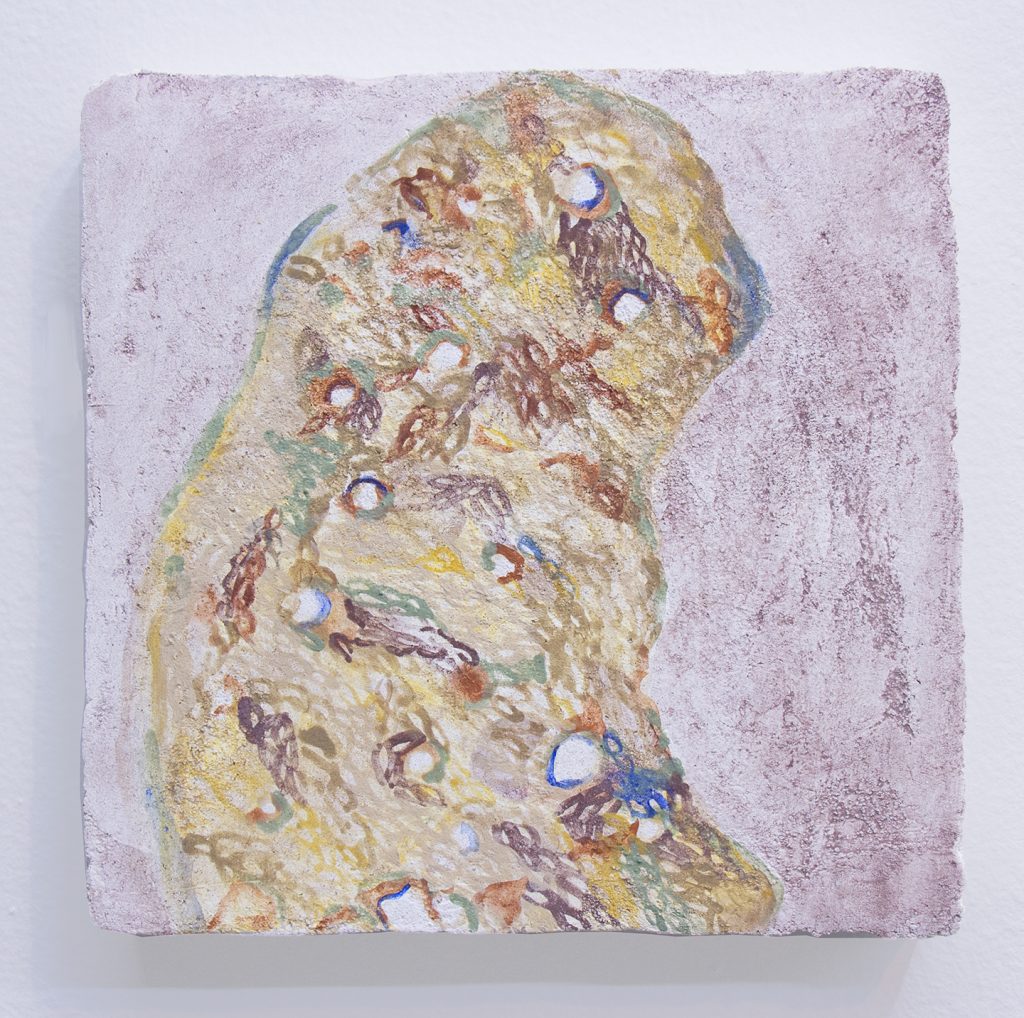My fascination with the possibilities of a video installation was renewed after experiencing a couple of remarkably enthralling examples of that artistic type at this year’s Whitney Biennial, so I was pleased to find the centerpiece of the new exhibition “Lili Chin: Istoria’s Garden” — a three-channel video installation. The exhibition is the latest from Microscope Gallery in New York City’s Chelsea neighborhood.
“Istoria’s Garden” at Microscope Gallery
At least as far as I could tell, there wasn’t a narrative through-line in the video, which was 11 and a half minutes long and accompanied by paperclay sculptures that hung in front of the wall towards which the assemblage of footage was projected.
Also called “Istoria’s Garden,” the video component of the piece presented a series of images of vegetation and natural world environments that the gallery explained originate from far-flung areas: upstate New York, Wyoming, Australia, Japan, and Singapore. There’s an engaging variety in the actual kind of environment presented, which ranges from waterfronts to a forest, and the images flowed together with ease. For someone who’s not a botanist, there was no clear demarcation of their origin points on different continents.
Human and animal life make cameo appearances, but it’s primarily a combination of vegetation and water, in terms of content.
The three channels of the installation are played right alongside each other to effectively combine into one larger, living image. Meanwhile, the camera angles capturing these wide-ranging, living scenes are frequently moving, shifting across the environment before the respective channel of video clicks somewhere else, again and again, in a method of image-construction that feels itself living and breathing, somehow.
The pieces of image in each scene from the natural world plus the combination of scene after scene leave you feeling immersed in a gentle waterfall of spacious, shimmering videography.

Spotlighting Nature’s Rich, Wide-Ranging Variety
From an aesthetic angle, the lookout points that Chin’s video captures blend heartily full varieties of the kinds of forms and movement you’d really find in nature, showing how the shaping of a single leaf can somehow build directly into the cascade of a billowing forest, leading to a somehow eternal-feeling experience of it all that you could easily anticipate would continue, even without you.
But rather than alienation or senses of disconnect, it’s peaceful as you’re left awash in images we might usually miss. Everything progresses consistently, and scenes from across the planet really feel like they go together.
With environmental degradation at the forefront for so many, Chin’s approach cultivates a sense of personhood on the part of nature, enacting an empathy angle. The smooth consistency but unpredictability in the images that Chin presents in “Istoria’s Garden” suggest something caring but beyond us, giving a holistic perspective on the sometimes smothered or subsumed but persistent sparks inherent to the natural world that are the context of our physical existences in the first place.
But it all stays personal and gentle, as Chin stays away from the jarring and presents instead the quietly enrapturing. There’s something reassuring about the real-world environment’s undercurrents illuminatingly turned into a flowing, visual ecosystem in Chin’s work — so long as its origin, meaning the physical, tangible nature, is preserved.
Chin’s “aesthetic principles” include “composition, verisimilitude, and variety,” says Microscope Gallery — and indeed, she uses these elements to resounding effect.
Frescoes Reflecting the Ocean Floor
Also in the exhibition was a series of fascinating, visually striking, small-scale frescoes in which Chin is mirroring “historical photos by the International Ocean Discovery Program of sediment cores extracted from the sea bed,” says Microscope.
The facets that Chin is isolating in these works (all squares with sides 9 and a half inches long) mirror that large-scale video installation, as areas of pigment flow seemingly into and out of each other. The ensnaring patterns defy, perhaps, familiar human expectations of order, but you can nonetheless tell there is a guiding force behind their shaping (that being the oceanic processes).
In other words, Chin put on display a unifying, elevating visual current to these snapshots of sediments beneath the sea — things that in Chin’s work look alive, moving beyond our most familiar thought systems but not with any kind of malice. You could imagine a subset of the images as displaying figures without need of the forms comprising our own figures, meaning what humans look like. It’s like a face of God, whether you take “God” as a solitary force or energy flowing behind our existences.
Chin’s mirrorings of our environment’s visual ecosystems also feel, at times, vulnerable. The systematically unified but separate-from-us collections of form and color feel balanced precariously — hearkening back, of course, to the real-world problem of climate change. There’s a clear opening in the exhibition for a sense of stewardship both of the many living things that share space here and our own interactions with planetary ecology, caring for the planet, our shares of it, and ourselves.
“Lili Chin: Istoria’s Garden” is on view at Microscope Gallery through June 8. See more info at this link.


Featured image: Lili Chin, “Istoria’s Garden” (2024). Image courtesy of the artist and Microscope Gallery, New York.
You may also like
-
Diana Kurz at Lincoln Glenn in New York: A Review of a Shining Art Exhibition
-
Dustin Hodges at 15 Orient in New York City: An Ensnaring Exhibition at an Exciting Gallery
-
Maren Hassinger at Susan Inglett Gallery in New York: Reviewing an Uplifting Art Exhibition
-
Enzo Shalom at Bortolami in New York City: Reviewing an Entrancing Exhibition of Paintings
-
“Ben Werther: Townworld” at Amanita in New York City: Reviewing a Richly Memorable Art Exhibition